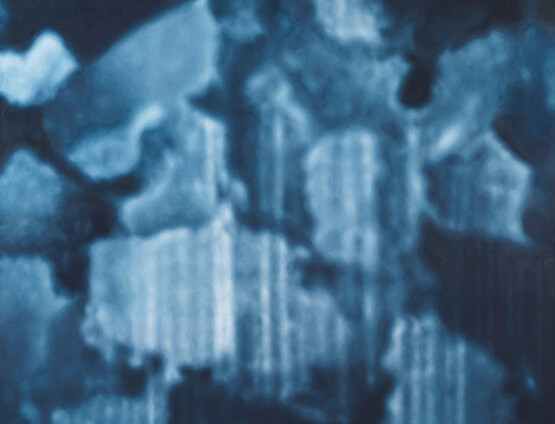
Y.Z. Kami
18.03.2020 • Reviews / Exhibition

Launched in 2017, the Lund Humphries Contemporary Painters Series sets out to assess the current shape of this discipline through a series of monographs, each dedicated to a leading practitioner. In recent decades the traditional notion of ‘schools’ of painting associated with specific localities has all but disappeared in favour of a more globalised dialogue. Reflective of this shift is the diverse group of artists chosen as subjects for the first batch of publications in this series.
Surveyed by John Yau, the work of Philip Taaffe (b.1955) exemplifies what painting can now be. Taaffe deploys unconventional techniques and works with unusual, often esoteric, subject-matter. In 1980s New York Taaffe gained renown for pictures that utilised relief and screen printing techniques to reconfigure the visual motifs of other artists. For instance, Undercurrent FIG.1 uses the undulating line characteristic of Bridget Riley’s paintings from the early 1960s. Only subtle shifts in colour distinguished Taaffe’s work from Riley’s black-and-white originals. Mimicry was a strategy common to artists of his generation yet, according to Yau, Taaffe used it to achieve something wholly different to the art of his peers. While other painters used tactics of appropriation as an ironic commentary on painting – the only recourse for a medium that had supposedly run out of ideas – Yau contends that Taaffe never aimed to be transgressive and instead intended to ‘shape continuity rather than create a rupture’ (p.12). Conceiving of culture as a shared heritage, Taaffe repeated existing motifs as a means of celebration, keeping them alive for the future. Yau notes that, when painting, Taaffe identifies with the traditional role of a scribe, as a conduit through which knowledge was preserved, rather than the more modern notion of an author, who aims to create something new. Ahmed Muhammed FIG.2 even incorporates a kufic monogram, reproduced from a calligraphy instruction booklet passed from scribe to scribe. The printmaking techniques Taaffe deploys help to conceal the artist’s hand while translating these found motifs into subtly different forms.
Yau develops his thesis on the motivations behind Taaffe’s distinctive approach to painting in the introduction and first two chapters of his essay. These sections also examine the artist’s youth, his education at Cooper Union under the conceptual artist Hans Haacke in the 1970s, and the subsequent development in the early 1980s of a labour-intensive method of constructing images through printmaking techniques. Later chapters focus on Taaffe’s widening field of reference since the mid-1980s, when he began to travel, incorporating motifs drawn from many cultures, and practice yet more innovative techniques. The last chapter explores how Taaffe’s reinvention of traditional craft since the millennium served to energise his practice, giving rise to paintings such as Trismegistus FIG.3, which was created through a marbling technique of the artist’s own devising. In explicating the wider conceptual motivations behind Taaffe’s work in the chapters charting his development in the 1970s and 1980s, Yau demonstrates how his position challenged that of the previous generation, who considered painting to be moribund. However, Yau only draws on recent interviews – those conducted since the millennium – to substantiate his arguments. It is an effective strategy, but one that fails to account for how the artist’s rationale might have first evolved.
Yau’s reappraisal shows how Taaffe has expanded what was possible in painting, incorporating a broader range of reference points and techniques as a means of breathing new life into the medium. Kaelen Wilson-Goldie’s subject, Etel Adnan (b.1925), has not been nearly as formally innovative, applying blocks of pure colour with a palette knife to modestly sized canvases in much the same way since she started painting in 1959. She began to receive significant critical attention in 2012, when she was included in Documenta 13, benefiting from an effort among curators to widen the canon and create a more inclusive narrative. And yet, in this, the first comprehensive study of the artist’s works, Wilson-Goldie illustrates how Adnan’s approach to the practice of painting is just as interesting as Taaffe’s. Her work revels in painting’s potential to provide an intensely pleasurable aesthetic experience that can actively transform our experience of the world.
It is a romantic vision for what is achievable in painting, but a fitting one for Adnan, who has been known chiefly as a poet for most of her creative life. Since she picked up a palette knife, aged thirty-four, Adnan’s approaches to poetry and painting have been closely related. ‘Two Desks’, the title of Wilson-Goldie’s second chapter, aptly describes the relationship between these disciplines for Adnan. The artist speaks of painting as a non-verbal, ‘open form of expression’, with a vocabulary of ‘colours and lines’ (p.66). Born in Beirut but having spent much of her life in the United States, Adnan sits at the intersection between cultures. For her, painting is akin to speaking Arabic, a language that she understands only imperfectly. As Wilson-Goldie charts Adnan’s turbulent life, shaped by politics and war, she describes how the artist’s creative output has allowed her to meditate on a difficult past. She reflects upon how, as a means of dealing with grief, Adnan’s abstractions have become more like landscapes, fixing upon certain forms: the distinctive shape of Mount Tamalpais in California, for example, which points upwards in the background of Untitled (Sausalito) FIG.4, or the sun (moon?) reflected in the sea, as the circles of Untitled FIG.5. Reading this account, our experience of both Adnan’s painting and poetry can only be enriched.